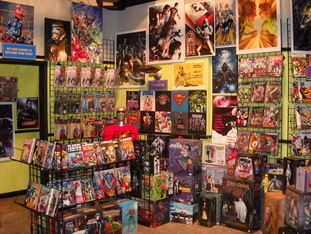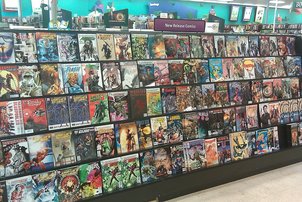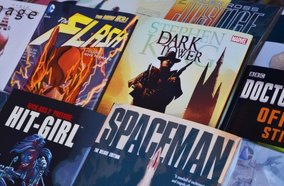Written by Joel T. Lewis Recently I found myself overwhelmed and frustrated during a recent visit to my local comic shop. I had just heard the news about Carrie Fisher’s passing and was in an awful funk: drifting from section to section and while I brought home some pretty sweet Issues of West Coast Avengers it made me sad to think that that trip wasn't as fun as it normally is. So I decided to write out some of the things I’ve learned from my comic book collecting experiences that help me make the most out of a trip to the comic book shop, to remind me how magical it is to shop for these incredible books and to help out anyone else who might be feeling a touch overwhelmed about starting their own collection as well. Your First Trip When going to a comic shop for the first time it's important to remember that the name of the game is fun. Comic books are meant to be fun: the colorful heroes, the wacky villains, and action-packed issues are for everyone so don't feel out of your element in a comic shop. Before you visit a comic shop check their website to make sure there are no events going on when you're planning on visiting. Lots of comic shops host trading card tournaments, auctions, and other events that are really cool, but might interfere with your trip. You don't want to squeeze around tables and chairs to get to the comics and you'll save yourself some funny looks from those attending the event. A note about comic shop owners: in my experience the owners, or employees of comic shops can vary from super polite and helpful to stoic and stand-offish. Despite their attitude, owners are more often than not huge comic book fans and it never hurts to ask for a recommendation. Usually it's helpful to have a hero or specific interest in mind when asking for a recommendation Example: I'd like something with a female main character set in space or I'd like something quirky but not necessarily about a superhero. In the event that the owner of your local shop is rude to you don’t be discouraged from collecting comics, we’re not all jerks! Do not allow yourself to be treated rudely, you can always find another shop to call home. When a shop-owner is nowhere in sight, or if you’re too shy to ask (which is perfectly fine) I've found that going with a friend who has their own comic collection is very helpful especially on your first trip to a comic shop. They'll usually know the lay of the land and will be able to steer you towards the unique stuff. Plus, they will be thrilled to introduce you to their world and will leap at the chance to visit a shop themselves. While I will try to cover as much as I can to help with your comic shop experience in this article, there really is no substitute for a fellow nerd buzzing with excitement to show you around.  When starting your comic collection, I've found that your greatest ally is the dollar comic section. Typically, these sections are full of issues that don't have bags or boards, are haphazardly organized, and are the best place to discover new heroes. You get to feel the ink on your fingers as you search through the boxes, you get that great smell that only loose comics have, and you can pick up a bunch of different titles without breaking the bank. These bargain bins are a great way to try on a hero or two for size before committing to hunting down every issue. Also the beauty of the dollar comic is that it's meant to be read. You don't have to worry about the quality of the issue or its value. So you can pick it up and thumb through it again and again without worrying about ruining it. It is important to know that in this section it is rare to find a first issue or a complete run and when you’re starting out and that’s okay. I know the frustration of finding issues 2, 3, 7, and 8 with none of the fillers in sight, but that’s the beauty of comics, you can read around the gaps and then you have something to hunt for the next time. This is also a great section for judging a book by its cover. Though I wholeheartedly believe that a comic book cover lets you know whether or not you will enjoy the story inside, this is not always the case (see my article on Image Comics’ Trencher). The dollar section protects you from investing in a title whose cover promised one thing and whose contents delivered another. Another ally to the new comic book collector is the Trade Paperback (TPB or trades) section. These are bound editions of comics that collect a number of issues in one volume. These will save you some money and the strife of tracking down obscure issues in a series. They also serve as great starter sets for new collectors. Some of my favorite trades are the Marvel Essential Series volumes. They're a great set of books that collect the first appearance of Marvel superheroes and allow you to follow that character’s story from the very beginning. The Essential series is great for filling in the holes in your collection but the only drawback is that the issues are in black and white. Most trades nowadays are full color and collect 5-10 issues at a time. They're great for saving space on your shelves, easy to keep in good condition, and don't break the bank. Now most comic collectors have strategies and resources that they go to when planning a trip to the comic shop and I just wanted to share a few of my own that have helped me make the most of my trips. Make a List Usually comic book shops organize themselves by publisher (Marvel, DC, Image, Vertigo etc) and then alphabetically under those headings. So I've found it's helpful to keep a list of the issues I have and the issues I want in an excel or google sheets spreadsheet. This format allows me to get everything alphabetized quickly and prevents me from buying duplicate issues. Also having a google sheet accessible from my phone allows me to edit it as I shop. When making a list of issues I want to pick up there are a few strategies I employ. When searching for issues I'm missing from a certain run I like to search for them on mycomicshop.com, in addition to being a huge comic book vendor themselves they have an intuitive website that allows you to see pictures of every issue’s cover art and they give you a ballpark price so you can plan your budget. Also their archive even has pictures of the issues they don't have available so you know what issue number and cover to look for. Something else that I thought was really cool about their website is that they list all the variant covers in a series too which has helped me pick up some pretty sweet issues.  When I'm not filling in gaps in a series, I'm usually looking for appearances of a specific hero (usually Moon Knight) in different comics. One of the most valuable resources I've found for tracking down these issues is comicvine.gamespot.com. This site hosts a pretty exhaustive catalog of comic book characters and their appearances in different issues. While the website has its quirks the research they've compiled is impressive. A word of warning though: when they list all appearances of a character they mean all of them, even translations into French and Spanish. Be sure to double check that the issues you write down are in the language you read and will be available in your country. Also, I've found that sometimes when a character is listed as appearing in some of the bigger comic book events like Flashpoint or Civil War that appearance can be underwhelming. Unless your character is central to the plot of those stories an appearance can be as small as a silent cameo in a splash page (a panel taking up one or two whole pages) of a New York battle and that's it. This won't be a problem for the more well-known heroes but the more obscure ones get included but not showcased. Stick to Your List Comics can get expensive. Depending on the scarcity and condition of specific issues $8-10 a pop is not an uncommon price point for comics and believe me, that adds up fast. So it is important to budget for a specific set of issues and stick to it. Allow yourself about ten dollars of cushion to account for something cool you may not have researched but if you establish a budget beforehand sticking to it makes a big difference when you step up the register. Give Yourself Enough Time Comics contain entire worlds. It's easy to lose track of time between their pages so make sure you give yourself enough time to explore especially the first time. Depending on the size of your local shop I recommend giving yourself 1-2 hours so you don't feel rushed. I love comic books and everyone should feel welcome in a comic book shop. Hopefully this article will inspire some aspiring collectors to make a trek out to a shop and will help the veteran collectors out there make the most of their next hunt. Please feel free to comment and share your comic shop strategies below. I'd love to hear some new ones. Until next time, Geek On!
0 Comments
Leave a Reply. |
Archives
May 2024
|
|
© 2012-2025, Nerds That Geek LLC.
All Rights Reserved. |
uWeb Hosting by FatCow
